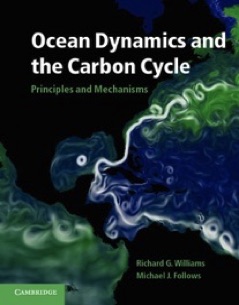
Ocean Dynamics and the Carbon Cycle: Principles and Mechanisms
by Richard G. Williams and Michael J. Follows
1. Reviews
'Bloody beauty.' Professor Trevor McDougall FRS, University of New South Wales, Australia.
'This is an outstanding book, likely to become the standard text for those needing to know both ocean physics and biogeochemistry.' Professor David Marshall, University of Oxford.
'For the last half century the study of ocean sceinces has been fractured along disiplinary lines ... By carefully interweaving the physical, biological and chemical fundamentals needed to understand the ocean's circulation and carbon cycle, Williams and Follows have made the ocean whole again.' Professor Susan Lozier, Duke University, USA.
'It is excellent reading and provides a fresh approach that will be of immense value to future generations of students and new researchers.' Professor Andreas Oschlies, Kiel, Germany.
'In this excellent book ... the authors have taken great care to introduce new topics in an accessible, intuitive manner before going into detail. It is well-illustrated ... with beautiful colour plates ... for which animated versions are provided online.' Dr Joel Hirschi for Weather, magazine of the Royal Meteorological Society.
3. Model animations from MIT and ECCO2
Model integrations and image processing by Oliver Jahn with Chris Hill, Stephanie Dutkiewicz and Mick Follows (MIT).
Available for global ocean, N. Atlantic, tropical Pacific and S. Ocean for sea surface temperature, mixed layer thickness, eddy velocity, surface chlorophyll and phytoplankton groups
To download animations, click on below link or via book resources using ink to Cambridge University Press
1.1 Global: model, current speed (m s-1) and surface chlorophyll (mg Chl a m-3) (26950KB, mp4)
1.2 Global: model, sea surface temperature (degrees C) (23308KB, mp4)
1.3 Global: model, mixed-layer-depth (m) (80981KB, mp4)
1.4 Global: model, eddy velocity (m s-1, based square root of eddy kinetic energy) (127600KB, mp4)
1.5 Global: model, surface chlorophyll (mg Chl a m-3) (38282KB, mp4)
1.6 Global: model, biogeography of phytoplankton types (mmol P m-2) (30248KB, mp4)
2.1 North Atlantic: model, current speed (white, m s-1) and surface chlorophyll (blue/green, mg Chl a m-3) (23864KB, mp4)
2.2 North Atlantic: model, sea surface temperature (degrees C) (23245KB, mp4)
2.3 North Atlantic: model, mixed-layer-depth (m) (82296KB, mp4)
2.4 North Atlantic: model, eddy velocity (m s-1, based square root of eddy kinetic energy) (113363KB, mp4)
3.1 Southern Ocean: model, current speed (white, m s-1) and surface chlorophyll (blue/green, mg Chl a m-3) (14969KB, mp4)
3.2 Southern Ocean: model, sea surface temperature (degrees C) (12605KB, mp4)
3.3 Southern Ocean: model, mixed-layer-depth (m) (42787KB, mp4)
3.4 Southern Ocean: model, eddy velocity (m s-1, based square root of eddy kinetic energy) (62753KB, mp4)
3.5 Southern Ocean: model, surface chlorophyll (mg Chl a m-3) (24205KB, mp4)
3.6 Southern Ocean: model, biogeography of phytoplankton types (mmol P m-2) (16758KB, mp4)
4.1 Tropical Pacific: model, current speed (white, m s-1) and surface chlorophyll (blue/green, mg Chl a m-3) (19674KB, mp4)
4.2 Tropical Pacific: model, sea surface temperature (degrees C) (13961KB, mp4)
4.3 Tropical Pacific: model, mixed-layer-depth (m) (53358KB, mp4)
4.4 Tropical Pacific: model, eddy velocity (m s-1, based square root of eddy kinetic energy) (117768KB, mp4)
4.5 Tropical Pacific: model, surface chlorophyll (mg Chl a m-3) (25001KB, mp4)
4.6 Tropical Pacific: model, biogeography of phytoplankton types (mmol P m-2) (18053KB, mp4)
These model animations from MITgcm and ECCO2 configured at 18 km resolution from January 1994 to December 1999 for the physics and January 1997 to December 1999 for the ecosystem; further details of the physical model, see Menemenlis et al. (2005) and the ecosystem model, see Follows et al. (2007).
The model animations include coupled physical and biological distributions (surface speed and chlorophyll), as well as additional physical (sea surface temperature, mixed-layer depth, eddy velocity) and biological distributions (surface chlorophyll and biogeography of phytoplankton types) over the globe and for selected regions over the North Atlantic, the Southern Ocean and the tropical Pacific (where there is a pronounced El Nino event in 1997/1998).
References:
D. Menemenlis, C. Hill, A. Adcroft, J. Campin, B. Cheng, B. Ciotti, I. Fukumori, P. Heimbach, C. Henze, A. Köhl, T. Lee, D. Stammer, J. Taft, and J. Zhang (2005). NASA supercomputer improves prospects for ocean climate research. Eos Trans. AGU, 86, 89, 95–96.
Follows, M.J., S. Dutkiewicz, S. Grant and S.W. Chisholm (2007) Emergent biogeography of microbial communities in a model ocean. Science, 315, 1843–1846.

Williams, R.G. and M.J. Follows, 2011: Ocean Dynamics and the Carbon Cycle: Principles and
Mechanisms. Cambridge University Press, ISBN: 9780521843690. 416 pages,286 b/w illustrations,
16 colour illustrations, 15 tables, 50 exercises. link to CUP
The book addresses questions of how the ocean circulates,
why plankton flourish over some parts of the globe and
how carbon is cycled between the atmosphere and ocean.
The book is designed for students wishing to gain an understanding of the fundamentals of ocean
sciences (involving transport, physics, biological processes and the carbon chemistry), as well as for
researchers wishing to gain an inter-disciplinary view of how the ocean behaves.
2. Contents
Part I Introduction
1. Why is the ocean important?
2. An introductory view of the ocean
Part II Fundamentals
3. Transport fundamentals
4. Physics fundamentals
5. Biological fundamentals
6. Carbon chemistry fundamentals
Part III Physical phenomena and their biogeochemical signals
7. Seasonality of the upper ocean
8. Ocean gyres and intense currents
9. Ocean eddies
10. Ventilation
11. Cycling and transport of nutrients and carbon
12. The deep ocean and overturning
Part IV Synthesis
13 Integral frameworks
14 Overview and further challenges
Appendix
A1 Mathematical definitions
A2 Derivation of the momentum equation
A3 Solving the carbonate chemistry system
Symbols and definitions
Glossary